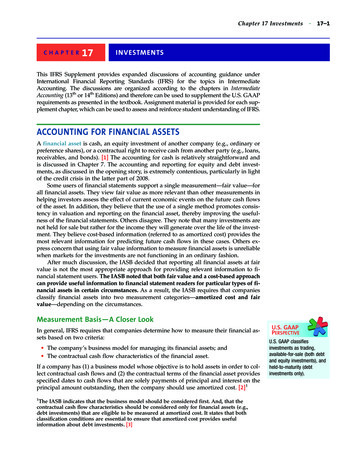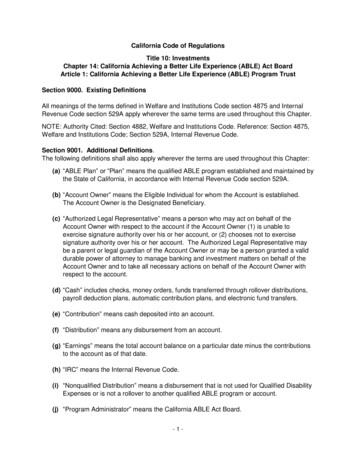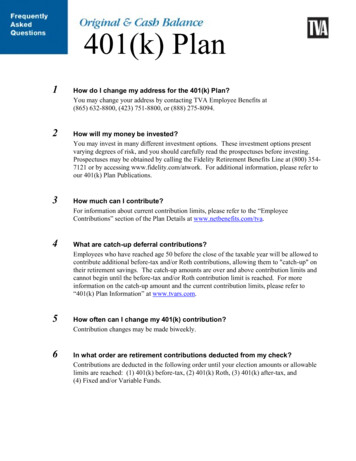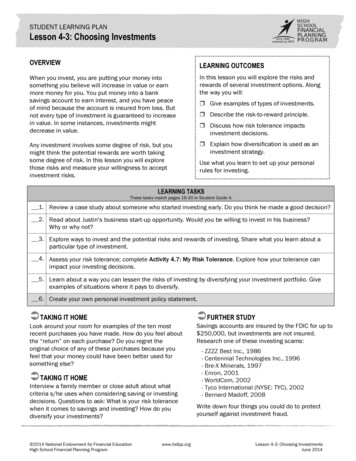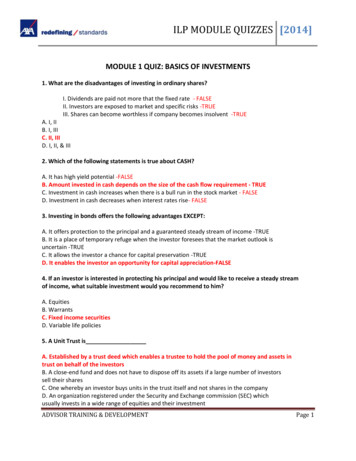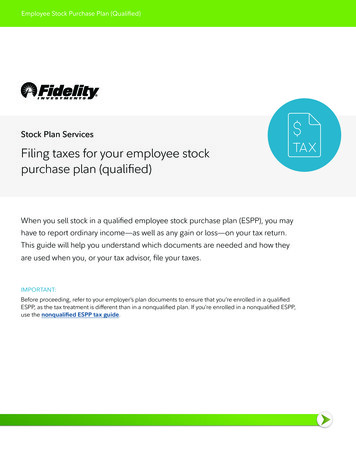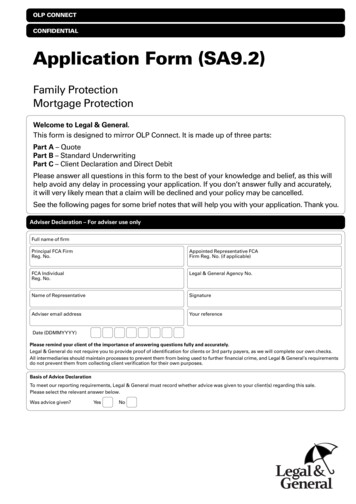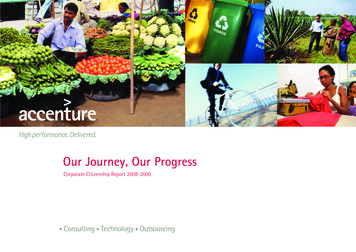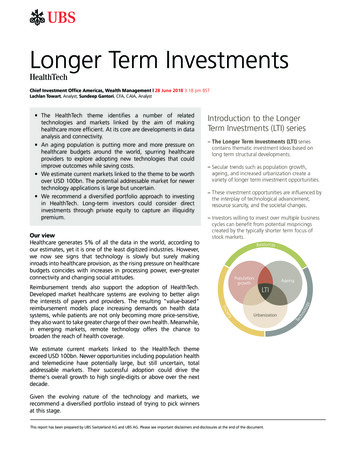
Transcription
Longer Term InvestmentsHealthTechChief Investment Office Americas, Wealth Management 28 June 2018 3:18 pm BSTLachlan Towart, Analyst; Sundeep Gantori, CFA, CAIA, Analyst The HealthTech theme identifies a number of relatedtechnologies and markets linked by the aim of makinghealthcare more efficient. At its core are developments in dataanalysis and connectivity. An aging population is putting more and more pressure onhealthcare budgets around the world, spurring healthcareproviders to explore adopting new technologies that couldimprove outcomes while saving costs. We estimate current markets linked to the theme to be worthover USD 100bn. The potential addressable market for newertechnology applications is large but uncertain. We recommend a diversified portfolio approach to investingin HealthTech. Long-term investors could consider directinvestments through private equity to capture an illiquiditypremium.Our viewHealthcare generates 5% of all the data in the world, according toour estimates, yet it is one of the least digitized industries. However,we now see signs that technology is slowly but surely makinginroads into healthcare provision, as the rising pressure on healthcarebudgets coincides with increases in processing power, ever-greaterconnectivity and changing social attitudes.Reimbursement trends also support the adoption of HealthTech.Developed market healthcare systems are evolving to better alignthe interests of payers and providers. The resulting "value-based"reimbursement models place increasing demands on health datasystems, while patients are not only becoming more price-sensitive,they also want to take greater charge of their own health. Meanwhile,in emerging markets, remote technology offers the chance tobroaden the reach of health coverage.We estimate current markets linked to the HealthTech themeexceed USD 100bn. Newer opportunities including population healthand telemedicine have potentially large, but still uncertain, totaladdressable markets. Their successful adoption could drive thetheme's overall growth to high single-digits or above over the nextdecade.Given the evolving nature of the technology and markets, werecommend a diversified portfolio instead of trying to pick winnersat this stage.This report has been prepared by UBS Switzerland AG and UBS AG. Please see important disclaimers and disclosures at the end of the document.
Longer Term InvestmentsLong-term investors willing to accept illiquidity may find attractiveopportunities to gain direct exposure through private equity investments.Fig. 1: Healthcare is one of the least digitizedindustriesLevel ofdigitalisationICTMediaHealthTech: Making healthcare more efficientToday, healthcare is one of the least digitized of the major globalindustries (see Fig. 1). But we see growing signs that healthcareproviders, insurers, and even drug companies now recognize thepotential for digital technology to improve efficiency and help checkthe relentless growth of healthcare spending around the world. TheHealthTech theme identifies technologies and market opportunitieslinked by the aim of making healthcare more efficient in two ways: Improve outcomes. Artificial intelligence (AI)-assisted diagnostics that consider all available evidence, predictive analyticsto detect hidden co-morbidities, and individualized drugs withreduced side effects are all potential ways HealthTech can providepersonalized care and improve treatment outcomes. Improve efficiency. Reducing errors and unnecessarytreatment, emphasizing preventive care, and shifting treatmentto cheaper locations without impacting quality can all help reducethe cost of healthcare. According to Cotiviti, USD 900bn is spenton potentially unnecessary treatment every year in the US alone.HealthTech's key drivers are the need for greater efficiency inhealthcare delivery, the rapid growth of processing power thatenables big data analysis and artificial intelligence, and better connectivity allowing care to move outside the hospital. As these trendshave coalesced, a number of software and consumer technology companies have begun to explore the healthcare market, and venturecapital has also seen the opportunity. The widespread adoptionof smartphones may also spur further technological changes inhealthcare delivery.At the core of HealthTech is the ability to store, retrieve and analyzethe vast mountain of healthcare data, which we estimate will reach2.2 zettabytes by 2020. We also consider adjacent technologiesinvolved in automating treatment and diagnosis. Examples include:Finance & InsuranceHealthcareRetailOil & GasFood & BeveragesAutomotive / DiscreteMining & Rail & Road LogisticsIndustrial end marketsOther industriesTimeSource: Based on ABB, slightly adjusted by UBS. As of May2017. Note: ICT Information and Communications TechnologyFor further reading: "Longer Term Investments - Enabling technologies," 21 May 2018 "The economics behind long-term themes,"20 February 2018 "Corporate Health - UBS Wealth Management White Paper," 2 November 2017 "Longer Term Investments - Generics, " 5July 2017 Population health software that applies big data analytics toproactively manage the health of a large group of patients atlower cost than current volume-driven approaches. Telemedicine to lower the cost of care by shifting treatmentfrom expensive hospital locations to the home. The average costof a telehealth consultation in the US is USD 40, compared to aUSD 125 in-person consultation, according to Citi. Integrating real-world evidence into the drug developmentprocess to improve clinical trial efficiency, reducing patientnumbers and boosting drug net present values (NPVs). AI-assisted diagnostic imaging to free up physicians' time formore complex cases.Chief Investment Office Americas, Wealth Management 28 June 20182
Longer Term InvestmentsWhile some argue that the industry is at a tipping point, we cautionagainst seeing HealthTech as a panacea. The vision of a fully-integrated, connected and data-centric healthcare system is appealing,but there are many challenges to digitizing healthcare, including technical, commercial, regulatory, and social. HealthTech as a theme isloosely defined and likely to evolve over time.In this report, we explore the drivers of greater digitization ofhealthcare provision, highlight potential technology applications andattempt to quantify the addressable market.Fig. 2: Life expectancy rising worldwideLife expectancy at birth, years9085807570656019801990ChinaKey drivers of the HealthTech theme20002010JapanUSHere we set out the factors that support the adoption of HealthTechand summarize its potential practical applications. We provide a moredetailed analysis of each of the key technologies and related marketsin the appendix.The need for change: Aging is driving an unsustainable rise inhealthcare costsHealthcare spending has long been seen to be on an unsustainablepath in many developed economies. Despite a growing awareness ofthe problem, there appears little respite in sight for both developedand developing economies: Demand for healthcare shows no signs of slowing. Lifeexpectancy is rising in both developed and developing markets.The over-65 population, which accounts for two thirds ofhealthcare spending, will likely more than double by 2050(see Fig. 2). Also, ongoing urbanization in the emerging worldincreases the prevalence of "lifestyle diseases" like obesity anddiabetes. Healthcare expenses are rising relentlessly, driven by bothhigher utilization and underlying cost inflation. OECD countriesalone spent USD 6.5 trillion on healthcare in 2016 and expenditure is also rising rapidly in the developing world (see Fig. 3).Costs are projected to keep rising: in the US, the Centers forMedicare and Medicaid Services (CMS) predicts that healthcareexpenses will reach 20% of GDP by 2026 (see Fig. 4).These trends are having a number of important effects on healthdelivery and consumption. Payers are increasingly focused on preventive care and population health: evidence is already building ofa shift to new reimbursement systems that reward quality and valueof care instead of the amount of services delivered. Equally, patientsare becoming more like consumers, paying more out-of-pocket, buttaking a greater interest in their health choices. We discuss the linksbetween HealthTech and value-based care in more detail below.HealthTech can exploit the rapid growth of healthcare dataWhile technology is only slowly creeping into healthcare provision,the industry is already overwhelmed with data. UBS estimates thathealthcare will account for 5% of all data generated globally, orroughly 2.2 zettabytes, by 2020. To put this into perspective, it isalmost twice the total amount of data generated globally across all202020302040Latin AmericaWestern Europe2050WorldSource: UN, UBS, as of July 2015Fig. 3: Healthcare costs rising as a share of GDParound the worldNational healthcare expenditure as a share of GDP18%16%14%12%10%8%6%4%2%0%1995199820012004United GermanyUnited KingdomTurkeySource: World Bank, as of September 2017Fig. 4: Healthcare costs are expected to keeprisingUS healthcare expenditure as a share of GDP20%19%18%17%16%15%2010 2012 2014 2016 2018 2020 2022 2024 2026US healthcare spend as a percent of GDPProjectedSource: CMS, as of June 2018Chief Investment Office Americas, Wealth Management 28 June 20183
Longer Term Investmentsindustries in 2010, highlighting the exponential growth in healthcaredata alone.By 2030, based on our latest estimates, the healthcare industry shouldgenerate more than 23 zettabytes of data, which is more than 10times the size of data the industry is expected to generate in 2020, orroughly the total amount of data generated globally across all industries in 2017.So far, the healthcare industry has been better at generating datathan it has been at using it. But new developments in artificial intelligence and data handling technologies, as well as improvements inconnectivity, suggest the industry may finally be reaching a tippingpoint. From a practical perspective, electronic health records are nowwidely adopted in many Western markets and regulators are focusedon driving standardization across healthcare IT systems.Meanwhile, a raft of start-ups and established software companiesare exploring how to integrate artificial intelligence, big data and evenblockchain into healthcare systems, with the aim of making better useof the vast mountain of data produced daily by healthcare systems.On an individual level, this could improve diagnosis. On a populationlevel, opportunities include the reduction of total treatment costsfor healthcare systems, faster and more efficient drug discovery and,potentially, predicting pandemic emergence.The location of care is also changing, with smartphone-enabledtelemedicine allowing patients to access care whenever and whereverit suits them, while saving costs for health insurers at the same time.Adoption is still in its early stages: while many consumers, especiallymillennials, turn to the internet for basic health advice (the so-called"Dr Google") and finding physicians, the penetration of telemedicineand wearable devices is still low (less than 10% and 20%, respectively,according to Rock Health). Telemedicine in particular could improveaccess to care in the emerging world.Technology companies and VCs have seen the opportunityHealthcare is a complex and heavily regulated industry. Importantregulations often differ at national and even regional levels and aresubject to frequent change. For this reason, the core healthcare ITmarket has historically been relatively unattractive to large enterpriseIT companies that seek scalable products with a global market opportunity. But this may be changing: as the demands on healthcare ITsystems change, and regulators demand new standards to ensureinteroperability, the analysis of data, rather than just its collection andprocessing, becomes more valuable. Already, software companies areinvesting in multiple health-related projects, while consumer-focusedtechnology companies look to partner with established healthcarecompanies. Wearable devices in particular could offer a route into theindustry for companies with respected consumer brands (see CaseStudy 1).Case Study 1: Amazon using technology todisrupt US healthcare servicesAmazon provides one of the most visible examples oftechnology companies trying to enter the healthcaremarket. In January 2018, Amazon announced a JVwith JP Morgan and Berkshire Hathaway aiming touse technology solutions to improve patientsatisfaction and reduce healthcare costs. Though fewdetails are available so far of the new company or itstechnology, early comments suggest it will employbig data, "virtual technology" and telemedicine,while attempting to offer patients choice andengagement through wellness and lifestyle programs.We expect the JV to initially focus on reducing costsfor its owners' employees, and if successful it couldlook to make a similar approach available to other USpatients. We think this JV bears watching as a highprofile exponent of many of the technologies coveredby the HealthTech theme. But we expect relativelyslow progress with the JV being built out at ameasured pace. Before the announcement, mediareports said Amazon was interested in developinghealth technologies, including telemedicine andelectronic medical records.Startups are also developing a number of new products at the intersection of health and technology, with a wave of venture capitalinvestment into the space in recent years. Since 2010, an estimatedUSD 30bn of venture capital (VC) funding was invested in the sector;Chief Investment Office Americas, Wealth Management 28 June 20184
Longer Term Investments2017 was the most active year on record, with USD 7bn invested,according to data from CB Insights.Changing social perspectivesChanging social preferences are also relevant to the adoption ofHealthTech, in our view. The ubiquity of smartphones and youngerconsumers' (particularly millennials) comfort with remote interactionshave changed attitudes to sharing personal data and information.Privacy justifiably remains a concern, however. While millennials arestill too young to be the main users of healthcare, we think that attitudes have shifted as a result of technological changes. We also findevidence that attitudes vary from nation to nation, with much lessconcern about data sharing in some Asian countries, such as China,as compared to the US and Europe.Several challenges may limit the pace of changeGiven all these positives, the world of healthcare may seem to be onthe brink of a data-driven revolution. However, we note a numberof challenges that will need to be addressed before there is a wideradoption of HealthTech technologies. Healthcare is, for good reason,a heavily-regulated industry, and regulatory change tends to comeslowly. Regulations differ around the world, and even sometimesbetween states of the same country. Ethical standards can also varyfrom place to place, and a given use of patient data may be acceptablein one culture but be a taboo in another. Moreover, healthcare provision is labor-intensive, and patients may not like losing contactwith their human doctors. And while healthcare costs appear to bereaching a tipping point, they have been rising faster than inflationfor many years. In short, we do not expect software to replace doctorsin the foreseeable future. But we believe it is prudent to position forchange in the healthcare industry even though that change may takesome time to come.Value-based care and HealthTechWe see the emerging growth of HealthTech applications as part of abroader set of trends, with both payers and patients affected financially by the rising cost of healthcare provision. Healthcare payers (typically governments and insurers) are exploring new reimbursementmodels that incentivize quality of care and greater value for money.Meanwhile, on the patient side, behavior is changing and price elasticity is increasing as costs are shifted to the user. The former trendis likely positive for treatment outcomes, while the latter has thepotential to be negative if not carefully managed. Both provide opportunity for companies in the HealthTech theme, in our view.Value-based care: Measuring outcomesWe believe many healthcare systems are at the early stages of a fundamental change in how healthcare is paid for. Reimbursement modelsare evolving to align the interests of providers with both payers andpatients, by linking the price paid to the outcomes achieved ratherthan the volume of service provided and encouraging providers toshare the financial risk that comes with managing the health of a poolor population of patients. Such an approach is generally referred toas "value-based care" or "value-based reimbursement".Chief Investment Office Americas, Wealth Management 28 June 20185
Longer Term InvestmentsValue-based care is not yet widely-adopted although many countries have begun to experiment with alternative payment models thatreward better quality of care through financial incentives. These newreimbursement models include bundled payments, value-based payments, shared-risk frameworks and capitated payments. For example,in the US, trials were held for a number of alternative payment modelsfollowing the enactment of the Affordable Care Act in 2010, andmore recently US Health Secretary Alex Azar confirmed that a transformation to value-based reimbursement is one of the current USAdministration's top health priorities*.While the transition to value-based reimbursement will undoubtedlytake time, we think the direction of the move is already clear andwe expect alternative reimbursement schemes to be a key element ofcontrolling the growth of healthcare costs in the future. Just reducingwaste creates a huge opportunity: according to healthcare IT firmCotiviti, USD 900bn is spent on wasteful or fraudulent claims in the UShealthcare system annually. Savings could also be made by engagingpatients and spreading clinical and operational best practices.Fig. 5: Smartphone penetration is risingGlobal smartphone penetration, 7Global smartphone penetrationSource: UBS, as of March 2018All of these tasks require greater use of technology and exploitation ofhealth data to quantify where and how healthcare dollars are spent,and the outcomes associated with that spending. At a minimum,providers will need to adapt their data systems to cope with morecomplex reimbursement processes, but we also see a need for betterdata analytics and software solutions for clinical decision guidance,work-flow management for complex clinical cases, and co-ordinationacross multi-disciplinary teams. This puts HealthTech at the core of thetransition to value-based care.Healthcare "consumerization" supports the HealthTech themeIn the developed world, the rise in healthcare costs has forced healthinsurance policies to become less generous. This is most obviouslyseen with the rise of high-deductible health plans (HDHP's) in the US(see Fig. 6). As patients pay out-of-pocket for more of their healthcare,they become more price sensitive: the price elasticity of healthcaredemand is increasing. This can have a negative impact on health outcomes. For instance, data from UBS Evidence Lab shows that patientsare more likely to skip prescriptions as their co-pays rise (see Fig. 7).But patients are also becoming more involved in their care, facilitated by technology changes and the easier availability of healthdata, such as via smartphone apps. We believe this is a desirabletrend: the focus on outcomes puts more emphasis on prevention, andmore health-aware consumers should be less of a burden overall tohealth systems. We see these trends supporting various aspect
HealthTech Chief Investment Office Americas, Wealth Management 28 June 2018 3:18 pm BST Lachlan Towart, Analyst; Sundeep Gantori, CFA, CAIA, Analyst The HealthTech theme identifies a number of related technologies and markets linked by the aim of making health
